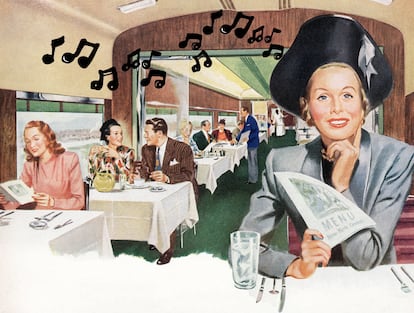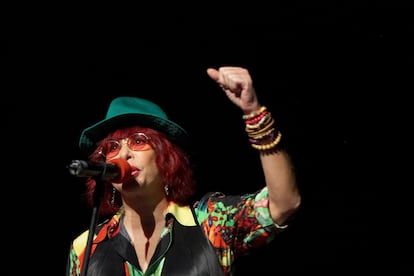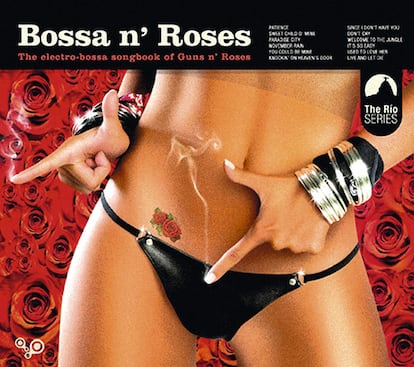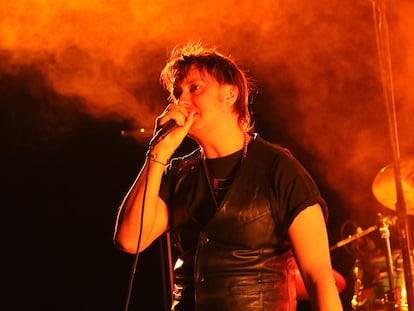‘A musical sausage factory’: The million-dollar business behind elevator music
Everyone has heard these songs… even if they don’t remember them. For decades, these bossa nova versions of great musical hits have invaded restaurants, offices, elevators and television programs. But where do they come from and who’s behind them?

You must have noticed the tune, unless you’ve spent the last few years hiding in the mountains, or lost in the desert. There’s a universal soundtrack that’s lurking at all times… and it’s not reggaeton.
We’re talking about versions of pop and rock anthems, performed by mellifluous voices. They have either faint pseudo-jazz instrumentation, or airs of bossa nova. A pandemic of supposedly elegant, highly forgettable music, with an unusual capacity to spread: it’s taken over cafes, restaurants, and after-work parties, while also infecting TV series and advertisements.
Its origins and authorship are, in most cases, a mystery: many of these Brazilian versions are performed by cover bands and soloists. They get millions of listens on Spotify and are backed by specialist labels. “I can understand it,” admits Diego A. Manrique, a legendary music critic. “When we talk about the musical revolution of the 1960s, we think of The Beatles… although there was a second [phenomenon]: the bossa nova. It wasn’t as attractive, but it penetrated all the countries of the world. And, in its instrumental aspect, it sneaked into hotels, clubs and restaurants, because it wasn’t rebellious music.”
For Manrique, the origins of this craze can be found in Music Brokers, an Argentine record label. At the beginning of the 2000s, it began releasing compilations under the title Bossa n’ Jazz, in which the corresponding bossa nova cover or smooth jazz varnish is applied to songs by famous artists, including Madonna, Rihanna, Bob Marley and Adele. EL PAÍS hasn’t been able to contact Music Brokers, but Manrique guesses that the label “must have a large team of instrumentalists and singers, whom they baptize with invented names.”
“Almost all of the [albums] have similar covers,” the music critic continues. “[Either] a girl wearing a bikini, or cut-off jeans, depending on the musical style. The ‘success’ — in quotes — is to sell it as an erotic and sophisticated product, while giving it a more contemporary sound than the LPs from the 1960s or 1970s.”

Manrique also points out the trick of inventing an entire rock scene with a bossa nova sensation, “when there was no such movement. It was just the work of some very smart guys. It’s a wonderful deception that has worked. There are albums that make me laugh… but I can’t deny that I’ve played one [in the car]. It gives the impression that you’re not listening to versions made in a [manufactured] manner, but rather that it’s an artistic project with substance. When, in reality, it’s a musical sausage factory.”
Charlie Sánchez was president of the Warner Music Group in Spain from 2007 until 2020. This is the record label that, in 2005, began licensing Music Brokers’ compilations in Spain, when the firm was still based in Argentina (it has now moved to the United States). Sánchez describes how, with the devaluation of the peso in the South American country, great local musicians found themselves working precariously. “Many joined these projects, which are technically super [legitimate]. And there are even geniuses [among the teams],” he argues, in a telephone conversation with EL PAÍS. “Daring to put out bossa nova covers of The Rolling Stones is tremendous — that’s why we released them.”
He’s referring to Bossa n’ Stones (2005), the first Brazilian artifact from Music Brokers, in which an Argentine singer, Karen Souza, performs a version of Wild Horses. She’s one of the few artists who has triumphed live with this genre, performing in venues and festivals in Madrid and Barcelona. “I was very much into lounge and chill house music,” she recalls by phone from Buenos Aires. “They listened to my voice and asked me to sing jazz… something I had never tried. Then, it turned out that my version of Do You Really Want To Hurt Me (Culture Club’s 1982 hit) was the most-listened-to on the [compilation] album. After that, I managed to build a personal career.”
Souza has become the most-played Latin jazz voice in the world. Her adaptation of Every Breath You Take by The Police has 70 million listens. “They’re great songs that, in rock terms, would be a little strong for a supermarket. And, somehow, they’re revalued by returning them to the present with a different rhythm,” says Souza, who has just released Suddenly Lovers (2023), which includes original compositions that she produces herself.
According to Charlie Sánchez, who now leads his own label of emerging artists, Metales Preciozos (“Precious Metals”), the precursor of this is Rita Lee, the singer and founder of Os Mutantes, the tropicalist and psychedelic band of the 1960s. In 2001, she recorded Aquí, Ali, Em Qualquer Lugar — the Brazilian version of Here, There and Everywhere by The Beatles — whose CD had a sticker that said “Bossa n’ Beatles,” with the aim of making it more appealing to the general public.
“Let’s see who tells me that Rita Lee has no authority to do this,” Sánchez says defiantly. “That album is seminal.” In his opinion, another artist who had a major influence on this style is José Padilla, one of the inventors of “chill-out music” and the Balearic house music of the 1990s. “The two of them are the indisputable godfathers of this genre,” he affirms.

Sánchez says that when he worked with Federico Scialabba, the president of Music Brokers, the Buenos Aires-based company already had a catalog of 15,000 compositions. “They had a lot of production equipment,” he recalls. “It’s similar to what happened with Motown or Stax — that their musicians played with a multitude of artists, whether they were The Supremes or Marvin Gaye.”
There was a time when this confluence between rock and bossa nova was received with open arms in the indie scene. In 2004, the Parisian duo Nouvelle Vague released their self-titled debut on the independent Peacefrog label. Their adaptations of punk, post-punk and new wave songs — originally by bands such as The Undertones, The Clash, or The Cure — were the best in certain environments. They often included famous French singers, like Camille.
“At first, we were a surprise, because we were a cover band, but also an alternative group that you could see live. We weren’t a lounge thing,” says Marc Collin, the only original member of Nouvelle Vague who is still alive, in a video call with EL PAÍS. His bandmate, Olivier Libaux, passed away in 2021. “Everyone thought it was a brilliant idea… although there were definitely those who thought that this was a project to listen to in cocktail bars, since most of our audience was made up of fans of the original bands. [But] many thanked us for giving a second life to those compositions.”
In February of 2024, Nouvelle Vague released their fifth album: Should I Stay Or Should I Go? They added synthesizers to deconstruct other milestones from the 1980s. Collin remembers how they pioneered this mix. “I think it occurred to me in 2003. I asked some friends what they thought of the idea of doing Depeche Mode or Joy Division songs in a bossa nova style. Everyone looked at me strangely. That was always on my mind. So, together with Olivier, we decided to record four songs. We soon realized that this was something very fresh.”

Without intending to, the French duo founded a type of new lounge music: elevator music. “It’s true,” he acknowledges. “But, at the time, nobody wanted to make covers of songs from the 1980s, because they weren’t considered cool at all. Suddenly, though, the audience realized that those [covers] — which could be very punk or very electronic — had great melodies. It’s true that many of the things that came out later were purely commercial products, with no band behind them… they’re just playlists for hotels. But that’s totally different from our [esthetic]. We’re not a marketing product. Sometimes, this boom bothers me a little, especially when I see something that’s too inspired by Nouvelle Vague.”
Perhaps the problem isn’t the sound, but its current ubiquity. “I estimate that these rock versions with a Brazilian varnish have been causing a lot of trouble for about 10 years now,” says Juan Laguna, artistic director of the Recoletos Jazz Room in Madrid. He manages the programming of this club, which is dedicated to jazz and flamenco. On the side, he freelances as a musical advisor in the hospitality sector. Up until last year, he was the musical director of Grupo Paraguas, which operates well-known restaurants in the Spanish capital, such as Amazónico or Aarde. “This sound became popular… [it had] a pretension of elegance, which is the point of this music. Since the rhythm is bossa nova and the melody is generally good — because it comes from a hit song — it seems somewhat sophisticated, when it’s really completely tacky.”
Laguna details the reasons for the success of this tune. “It’s a kind of music that has very few dynamics. The bossa nova versions are designed to make the clientele talk about them and feel comfortable. They don’t try to stir up any feelings: what excites you is the melody of the song, which the listener already recalls. The idea is that they don’t bother anybody — they can be loud, because they have to accompany the client, fight against their loneliness, provide some atmosphere. In that sense, they’re perfectly made, they’re wonderful.”
There are companies specialized in creating these musical threads, which are organized according to the time: lunch, afternoon, dinner, or the first drink at the bar. “Everything is very mechanized,” Laguna explains. “The essential thing is that they’re very flat songs: the moment there’s a certain [surge], the client feels uncomfortable. This has nothing to do with the bossa nova of the 1960s or 1970s… those compositions were designed to be savored, not to give some ambience [while you eat] the artichokes on your plate.”
These versions reached their peak six or seven years ago and still remain popular. Something similar to what happened at the beginning of the century, when chill-out music invaded terraces and beach bars. “Both are very productive types of music,” Laguna adds. “They generate a lot of rights, because they’re played everywhere. Sometimes, a song is played up to 10 times a day in the same restaurant. And I think there’s still room for this to grow.”
The omnipresent Brazilian tune gives Laguna a morbid sensation. “It really makes me wonder… the bastards do it well! If it catches my attention as a professional, imagine someone who’s not. He’s going to like it by force! Furthermore, intellectually, you don’t feel like a fool, because you recognize what’s being played. On the one hand, it makes me jealous when I imagine the person who created this… but on the other hand, it seems like a horror that kills the soul of great compositions.”
Charlie Sánchez, of course, cannot agree. “It can’t be so bad if it has withstood the test of time. It’s surprising that it’s being played more than ever. Maybe when we were at Warner, we didn’t do it so well, [we missed out on the elevator music boom]. Or, it could be the other way around: we did it so well that all this [success] has come from that ember.”
Sign up for our weekly newsletter to get more English-language news coverage from EL PAÍS USA Edition
Tu suscripción se está usando en otro dispositivo
¿Quieres añadir otro usuario a tu suscripción?
Si continúas leyendo en este dispositivo, no se podrá leer en el otro.
FlechaTu suscripción se está usando en otro dispositivo y solo puedes acceder a EL PAÍS desde un dispositivo a la vez.
Si quieres compartir tu cuenta, cambia tu suscripción a la modalidad Premium, así podrás añadir otro usuario. Cada uno accederá con su propia cuenta de email, lo que os permitirá personalizar vuestra experiencia en EL PAÍS.
¿Tienes una suscripción de empresa? Accede aquí para contratar más cuentas.
En el caso de no saber quién está usando tu cuenta, te recomendamos cambiar tu contraseña aquí.
Si decides continuar compartiendo tu cuenta, este mensaje se mostrará en tu dispositivo y en el de la otra persona que está usando tu cuenta de forma indefinida, afectando a tu experiencia de lectura. Puedes consultar aquí los términos y condiciones de la suscripción digital.
More information
Archived In
Últimas noticias
Rowan Atkinson tops Netflix at 70: ‘He’s as funny as ever’
Israeli recognition of Somaliland stirs up the Gulf
Tiger Woods turns 50: Will he continue playing on the PGA Tour or take a back seat?
The surreal journey of James Nnaji, the Barcelona youth player selected in the NBA Draft who ended up in the NCAA
Most viewed
- Oona Chaplin: ‘I told James Cameron that I was living in a treehouse and starting a permaculture project with a friend’
- Reinhard Genzel, Nobel laureate in physics: ‘One-minute videos will never give you the truth’
- Sinaloa Cartel war is taking its toll on Los Chapitos
- Why the price of coffee has skyrocketed: from Brazilian plantations to specialty coffee houses
- Chevy Chase, the beloved comedian who was a monster off camera: ‘Not everyone hated him, just the people who’ve worked with him’










































